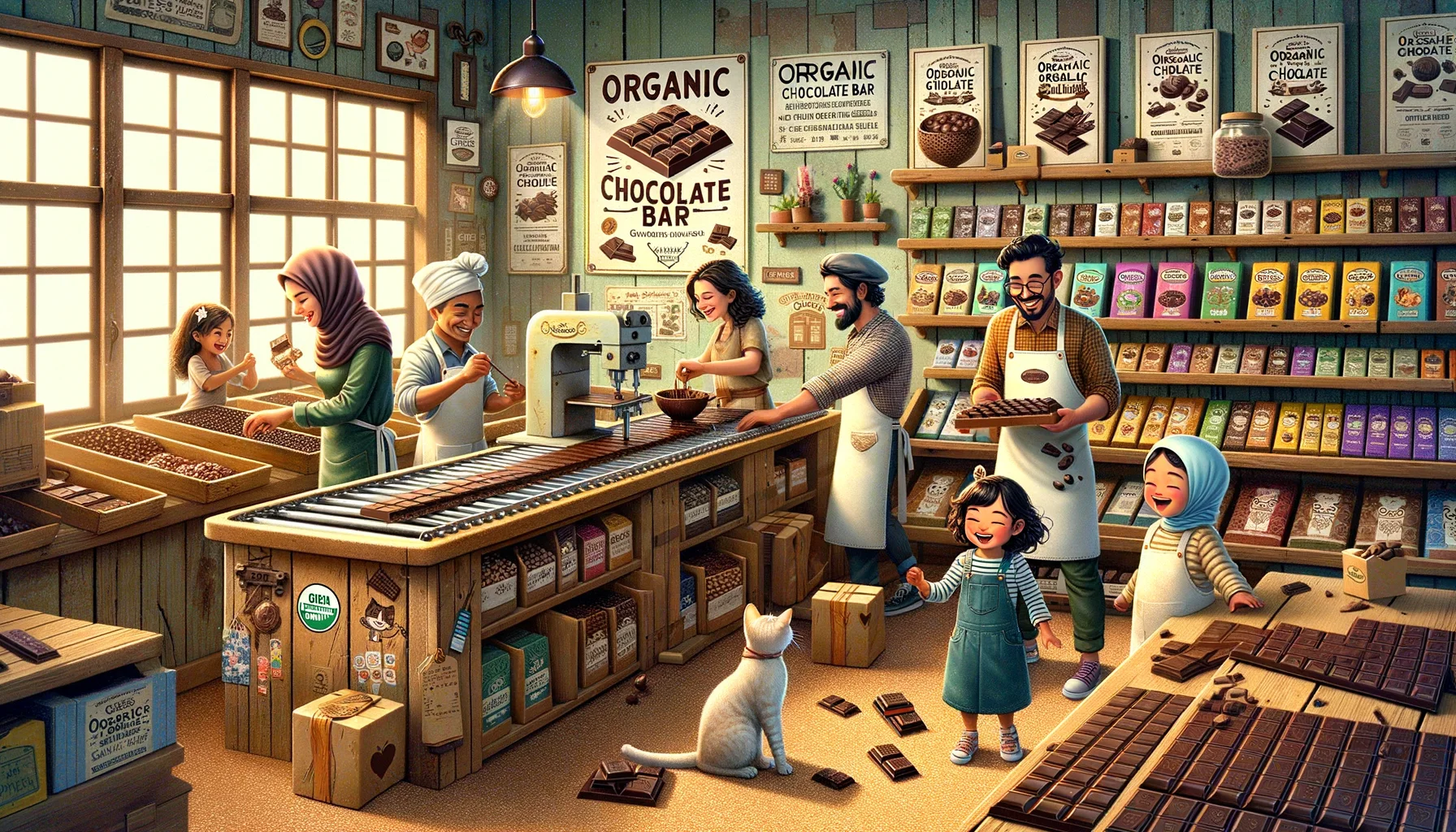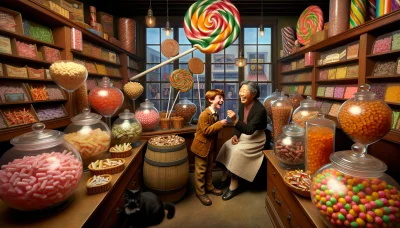Shop for Organic Chocolate Bars Quiz
Test Your Knowledge
Question of
Understanding Organic Chocolate
There's something about organic chocolate that just feels like a hug for your soul, doesn't it? Let's unwrap the mystery like a foil-covered treat. At its essence, organic chocolate is made from cocoa beans that have been grown without the use of synthetic pesticides or genetically modified organisms. It's not just a bar of chocolate; it's a whisper of the Earth's purest offerings.
The standards for what can be called 'organic' are quite like the rules of an exclusive club. Only those who meet the strict guidelines, pass rigorous inspections, and prove they're dedicated to natural processes get to wear the badge. And by badge, I mean the certification labels that assure you're getting the real deal. These labels are your trusty sidekicks in navigating the world of chocolates, ensuring every bite aligns with your values.
Labeling and identification - now there's a thrilling chapter in our chocolate saga! It's not just about spotting 'organic' on the wrapper; it's about understanding what lies behind those words. Each label tells a story of commitment to quality and purity, giving you one more reason to savor that delightful square of bliss.
Benefits of Organic Chocolate
When I think of the health advantages of organic chocolate, I picture each square as a tiny wellness warrior fighting for my well-being. Packed with antioxidants and often lower in sugar compared to their conventional counterparts, these bars are not just a treat for your taste buds but also a boon for your body.
But let's not forget Mother Earth she loves organic chocolate too! The environmental impact of organic farming practices is like a gentle footprint on a sandy beach compared to conventional methods. Fewer chemicals mean healthier soil and cleaner water, which makes every bite an act of eco-friendly indulgence.
And then there's supporting sustainable farming talk about feeling good about your snack choices! By choosing organic chocolate bars, you're casting a vote for fair trade practices and empowering small-scale farmers who pour their hearts into their crops. It's like sending a thank-you note to these guardians of traditional farming with every piece you enjoy.
Types of Organic Chocolate Bars
Dark chocolate varieties in the world of organic treats are like the enigmatic strangers at a masquerade ball rich, complex, and utterly irresistible. They range from sweetly approachable with just a hint of bitterness to boldly intense with cocoa contents that can skyrocket into the stratosphere.
For those who lean towards creamier confections, milk chocolate alternatives are like childhood friends - familiar and comforting. These bars offer all the creamy decadence you crave but with organic milk from happy cows grazing on unsullied pastures.
- Chili Infused Dark Chocolate A fiery dance on your palate.
- Sea Salt Sprinkled Milk Chocolate Like catching ocean spray on your tongue.
- Orange Zest Dark Chocolate A citrusy zing in a velvety embrace.
Unique flavor combinations are where things get really exciting they're like jazz improvisations in the world of chocolate. Think lavender-infused dark chocolate that blooms in your mouth or ginger-spiked milk chocolate that offers warmth with every nibble. Every bar is an adventure waiting to be savored.
How to Choose Quality Organic Chocolate Bars
Embarking on the journey of selecting a quality organic chocolate bar is akin to a treasure hunt. You're not just looking for any old piece of gold, but rather a gem that aligns with your values of sustainability, health, and pure indulgence. It's a sensory adventure that tantalizes the taste buds while honoring the earth and its resources.
When you reach for an organic chocolate bar, its not just about satisfying a sweet craving; its about making a conscious decision that impacts both your well-being and the environment. Let me guide you through the lush forests of cocoa-rich possibilities where every choice can be both decadent and principled.
Ingredients to Look For
Cocoa Content
The heart of chocolate lies in its cocoa content. The percentage you see etched on those elegant wrappers isn't just a numberit's an invitation to experience the depth and intensity of chocolate. Organic chocolate bars with higher cocoa content tend to offer a more robust flavor and are often less processed, allowing the true character of the cocoa bean to shine through.
As you peruse the shelves or scroll through pages online, remember that cocoa percentage is like choosing the pitch in a symphonythe higher it is, the richer and more intense the experience. A 70% or above is where you will find that perfect balance between bitterness and sweetness, where every bite becomes an immersive journey into what real chocolate should taste like.
Type of Sweeteners Used
The sweet symphony of chocolate can be either enhanced or overshadowed by the type of sweetener used. Organic cane sugar, coconut sugar, or even pure maple syrup can elevate your chocolate experience from ordinary to extraordinary. These natural sweeteners not only add layers of flavor but also reflect a commitment to using unrefined ingredients that harmonize with your body's needs.
Avoiding artificial sweeteners and high fructose corn syrup is like dodging those pesky potholes on the road to blissful indulgence. They may promise sweetness, but they can leave a lingering aftertaste that doesn't resonate with the authenticity we crave from organic treats.
Additional Natural Ingredients
- Nuts & Seeds: They add crunch and nutrition; almonds being my personal drumroll before every chocolatey bite.
- Fruit Pieces: Like little jewels embedded within, they bring bursts of tartness or sweetness.
- Spices: A pinch of cinnamon or a whisper of vanilla can transform a simple bar into an exotic escape.
Reading Labels and Packaging
Understanding Nutritional Information
Navigating nutritional labels is like decoding hieroglyphs that reveal secrets about our food. For organic chocolate bars, this knowledge empowers us to make choices aligned with our health goals. Pay attention to serving sizeschocolate is best enjoyed in moderationand look for bars with minimal added sugars and high fiber content; these are clues pointing towards quality ingredients and less processing.
Remember, each element listed on that label plays a role in the story your chocolate bar has to tell: from its origins as beans nestled in organic soil to its final form as your chosen treat. This story should align with one's pursuit of pleasure without compromising on health.
Identifying Certifications
In this world where words like 'organic' and 'natural' are tossed around like salad leaves, certifications stand as pillars of trust. Look for stamps of approval from USDA Organic, Fair Trade, Rainforest Alliance, or Non-GMO Project Verified. These badges are earned by brands committed to ethical practicesfrom bean sourcing to labor conditionsassuring you that your indulgence supports more than just your cravings.
Packaging Materials and Sustainability
The embrace between product and packaging is one we often overlook. Yet in that embrace lies the commitment to sustainabilitya value intrinsic to true organic products. Seek out brands that use recyclable or compostable materials; it's a testament to their respect for Mother Nature's cycles.
Taste Profile and Texture
Sampling Different Brands
Diving into different brands is like datingyou're getting to know what resonates with your palate's preferences. Each brand has its own signature touch: some might lean towards fruity notes while others pride themselves on their smoky undertones. Sampling helps build your flavor lexicon so you can articulate what tickles your fancy beyond just 'chocolatey.'
Recognizing Quality by Texture
The texture is where tactile meets taste; its an integral part of savoring chocolate. Quality organic chocolate should promise smoothnessa texture that melts evenly across your tongue without graininess or waxy residue left behind. It should break cleanly when snapped, whispering secrets about its fine tempering process.
Pairing with Foods and Beverages
- Coffee: The boldness enhances darker chocolates beautifullylike two old friends catching up over shared secrets.
- Cheese: Pairing cheese with chocolate might sound unconventional until you try itthe creaminess complements especially well with fruit-infused varieties.
- Wine: A glass of red wine alongside a rich piece of dark chocolate? Now that's what I call diving headfirst into decadence!
The Best Organic Chocolate Bar Brands
Have you ever had one of those days where the only thing that seems to soothe your soul is the velvety caress of chocolate melting on your tongue? Oh, but not just any chocolate. I'm talking about the kind that whispers sweet nothings of earthy cocoa and ethical sourcingthe organic chocolate bars. They're like the secret handshake of the confectionery world, a nod to those who appreciate the finer, purer things in life.
For me, delving into the realm of organic chocolate bars is more than a treat; it's a journey. Every bite is an exploration of exotic flavors and textures. The rich, complex notes that dance across my palate are a testament to the meticulous care taken from bean to bar. And let's be real, knowing that what I'm indulging in is free from synthetic additives and often supports sustainable farming practices makes each square taste all the sweeter.
But with so many brands on the shelves, claiming their spot in the organic limelight, how does one choose? Fear not, fellow chocophilefor I have embarked on this delicious quest before you and am here to share tales of my top picks for organic chocolate bar brands. Prepare your taste buds for a symphony of pure cacao bliss as we unwrap these treasures together.
Award-Winning Organic Chocolatiers
Let's start with the crme de la cacao. These award-winning organic chocolatiers have not just captured my heart but have also snagged international recognition for their exceptional creations. Each time I unwrap one of their bars, it feels like I'm holding a piece of artan edible masterpiece crafted with passion and precision.
International Recognition
The world stage has been graced by these artisans who transform humble beans into luxurious treats. Their global presence is not by chance; it's earned through dedication to quality and innovation in the world of organic chocolate making. It's almost as if each gold foil that encases their bars is a nod to their international acclaim.
Awards and Accolades
Shelves and virtual carts alike are adorned with these champions of taste. From 'Best Organic Dark Chocolate' to 'Most Innovative Flavor Combinations,' these accolades aren't just shiny stickers on wrappersthey're promises of a euphoric experience waiting within each bite-sized segment.
Signature Offerings
- The Single-Origin Sensation: A bar crafted from beans sourced from one particular corner of the globebe it the lush valleys of Peru or Madagascar's vibrant coastsoffering an unadulterated taste profile unique to its homeland.
- The In-House Roast: Where beans are roasted with such care that they unveil nuanced layers of flavor ranging from bold berry notes to hints of aromatic spices.
- The Infused Innovations: Bars that dare to blend unconventional ingredients like lavender or smoked sea salt, creating harmonies that resonate with adventurous palates.
Customer Favorites and Reviews
Now let's talk about popularity contests. In the world of organic chocolate bars, customer favorites are like trusted friendsthey never let you down. These crowd-pleasers have earned their spots through consistent love letters in the form of glowing reviews and repeat purchases.
Top-Rated Selections
I've scrolled through countless reviews, my eyes glazing over as much as my mouth waters at descriptions like "heavenly" and "a revelation." These top-rated selections come highly recommended by legions of fans who proclaim them as staples in their pantrya testament to their irresistible appeal.
Consumer Feedback
A five-star rating here, a "best I've ever had" comment thereit's clear these chocolates are doing something right. Consumer feedback is invaluable; after all, who better to trust than fellow enthusiasts who have savored every morsel?
Bestsellers and Why They Stand Out
Bestsellers aren't born overnight; they're forged in the fires of public opinion and emerge victorious as true champions of flavor and integrity. They stand out for their consistently high-quality ingredients, memorable branding, and ability to make us feel just a tad more sophisticated with every nibble.
Small-Batch and Artisanal Makers
Last but certainly not least are the small-batch heroesthe artisanal makers who pour their hearts into every mold. These chocolatiers remind us that sometimes less truly is more; each limited edition release feels like an exclusive invitation into their world of craftsmanship.
Handcrafted Quality
I can almost feel the dedication woven into the texture of these barsthe handcrafted quality that speaks volumes about attention to detail. It's personal, intimate even; each bite feels like partaking in someone else's passion project (and oh, what a delicious project it is).
Unique Production Methods
Innovation isn't just for tech geeksit thrives in chocolate workshops too! Unique production methods like stone grinding or long-conching times result in flavors so intricate they could very well be considered fine art for your palate.
Limited Edition Releases
If you've ever managed to snag one of these elusive limited edition releases, you know it feels akin to winning Willy Wonkas golden ticketa rush followed by an indulgent sense of victory. Exclusive batches mean exclusive flavors, often inspired by seasons or special collaborationsmaking each square all the more precious.
Storing and Savoring Organic Chocolate Bars
Proper Storage Techniques
Oh, the delicate dance of keeping a chocolate bar at its peak! It's like cradling a dream in your hands. You see, organic chocolate bars are not just treats; they're experiences waiting to unfurl. But before we dive into the symphony of flavors, let's talk about storage. The key is balance not too hot, lest your chocolate turns into a melancholic puddle, and definitely not too cold, as it may dull the very essence of its rich flavors.
Ideal storage for these bars of joy whispers around 65-68F (18-20C) with a hint of humidity, just enough to keep the air from stealing away the moisture. Tuck them away from strong-smelling neighbors in your pantry; you wouldn't want your chocolate whispering secrets of garlic or onions when it melts on your tongue. And heres a tip: if you must refrigerate them due to a warm climate, seal them in an airtight container with a love note (or parchment paper) to keep condensation at bay.
Ideal Temperature and Humidity
Imagine you're ushering your cherished organic chocolate bars into a sanctuary where the air is just crisp enough to keep them alert but relaxed. This sanctuary is none other than your very own storage space where temperature and humidity are guardians of longevity. The ideal temperature is a gentle embrace that ensures the cocoa butter within remains stable, preserving that delightful snap when you break off a piece.
Avoiding Contaminants and Odors
Let's be real nobody wants their chocolate tasting like last week's leftovers. And in this world where flavors intertwine, we must be vigilant protectors against unwanted mingling. It's all about isolation, my friend think of it as giving your chocolate bars their own little private villa away from the bustling city of other foods.
Long-Term Preservation Tips
- Wrap snugly in foil before placing it in an airtight container it's like tucking your chocolate into bed.
- Store away from light; even though it loves sunbathing, it does age the flavor prematurely.
- If freezing, first say a prayer, then double-wrap and ease back to room temperature slowly once you're ready to indulge.
Tasting Organic Chocolate Like a Connoisseur
There comes a moment when you realize that tasting chocolate can be as profound as listening to Mozart or gazing upon a Van Gogh. Engaging all senses is paramount sight lures you with its gloss, touch teases with texture, sound confirms quality with that satisfying snap, smell sets anticipation ablaze and finally taste... ah taste... carries you through waves of cacao, fruitiness, earthiness stories from lands afar.
To truly honor the journey from bean to bar, one must seek out those flavor notes hidden within folds of richness. Like deciphering hieroglyphs or sipping on wine while pondering Proust - identifying these subtleties requires patience and practice. And here's something for spirited souls: theres an order to this indulgence. Start with milder percentages and ascend towards intense darks; let each bar crescendo into the next.
Engaging All Senses
Close your eyes for just a moment as you let that first piece settle on your tongue. Feel how it starts off shy before blossoming into full-bodied confidence? That's what I'm talking about engaging all senses! Let sight admire the craftsmanship; touch explore the texture; hearing enjoy that snap; smell anticipate the flavors; and taste... well, that's where you fall in love.
Identifying Flavor Notes
Each bite is like playing detective with your tastebuds was that a hint of cherry? A whisper of almond perhaps? Or maybe an audacious dash of sea salt waving hello? Identifying these notes isn't just about fancy words; its about recognizing each bar's unique personality.
Tasting Order for Maximum Enjoyment
Begin with those gentle at heart milk chocolates or subtle infusions. Then venture deeper into the forest with semi-sweet varieties before plunging into the enigmatic depths of dark chocolates. This order isnt mere whimsy; its choreography for maximum enjoyment!
Creative Ways to Enjoy Organic Chocolate Bars
Now lets get adventurous because why should wine have all the fun with pairings? Your organic chocolate yearns for companionship too! Imagine sipping on a velvety Merlot as its tannins flirt outrageously with dark chocolate's boldness or perhaps some whiskey that beckons forth hidden smoky notes from within your chocolate bar.
Beyond companionship lies culinary alchemy where organic chocolate transforms dishes into artistry. Melted down and drizzled over strawberries or folded into pancake batter for Sunday brunch this isn't cooking; its crafting memories! And dont forget those special moments: birthdays wrapped in ribbons of milk chocolate sweetness or anniversaries celebrated with elegant dark slabs reminiscent of loves depth.
Pairing with Wines and Spirits
Theres something inherently romantic about pairing organic chocolates with wines and spirits. It speaks to our desire for discovery and indulgence. So go ahead uncork that bottle and unwrap that bar. Let them dance together across your palate in celebration of life's delicious complexities.
Incorporating into Recipes
Whether shaving slivers over morning oatmeal or creating truffles infused with lavender for an afternoon escape incorporating organic chocolates into recipes is akin to weaving magic into the mundane.
Special Occasions and Gifting Ideas
Think back to those moments when unwrapping an organic chocolate bar felt like unearthing treasure. Share that feeling! Gifting these bars means passing on not just treats but experiences dipped in joy and garnished with thoughtfulness.
Exploring the World of Organic Chocolate Bars
Origins and Bean Varieties
As I recall the first time I unwrapped an organic chocolate bar, there was a sense of anticipation - like uncovering a hidden treasure. The origins of these delightful treats are as rich and diverse as their flavors. You see, the geography where cocoa beans grow imparts distinct characteristics to each bean variety. Take for instance the criollo beans, often likened to the fine wine grapes of the chocolate world, offering complex and nuanced flavors that can evoke whispers of caramel or hints of fruitiness in your palate.
There's an ongoing debate among connoisseurs single-origin versus blended bars. Single-origin chocolate bars are made from beans harvested from one particular region or even a single farm, capturing the essence of that area's unique soil and climate conditions. These bars are like a love letter to their place of origin, each bite telling a story of sun-drenched days and earthy aromas. On the other hand, blended bars are crafted by combining beans from various regions, creating a harmonious symphony that can surprise you with its depth and complexity.
- Geographic Influence on Flavor: The soil, climate, and biodiversity surrounding cacao plantations deeply influence bean flavor profiles.
- Single-Origin vs. Blended Bars: A choice between a pure note or a complex chord of flavors.
- Rare and Sought-After Beans: Some varieties are so precious that they're almost whispered about in hushed tones by chocolate aficionados.
The Making of Organic Chocolate Bars
The journey from bean to bar is akin to alchemy, where humble beginnings transform into gold or rather, into luscious organic chocolate bars. This magical transformation begins with careful selection and roasting of beans, followed by grinding and conching where textures and flavors develop over hours sometimes days. The patience required here is not unlike nurturing a seedling into bloom; it takes time but is oh-so-rewarding.
While mass-produced chocolates might prioritize efficiency over character, artisanal makers embrace techniques that have been handed down through generations. They understand that true craftsmanship lies in the tiny details like tempering chocolate to just the right glossiness or infusing bars with locally sourced honey or lavender for that extra touch of wonder. Innovations continue to shape this craft; imagine stone-ground cocoa nibs lending an earthy grittiness to your bite or cold-pressing techniques preserving raw cocoa's potent antioxidants.
Seasonal and Limited Edition Bars
There's something quite special about indulging in seasonal chocolate bars that capture the essence of festivities. Holiday-themed flavors can evoke memories as vivid as snowflakes on your tongue think peppermint swirls mingling with dark cocoa during winter celebrations or pumpkin spice notes warming your soul in autumn.
Ingredients harvested at their peak bring an extraordinary vibrancy to seasonal bars. Imagine biting into a piece where summer berries burst forth with their tangy sweetness or autumn nuts add a comforting crunch under layers of smooth chocolate. And then there are those collectible bars - released as limited editions - which seem almost too precious to eat... almost. They're like capturing a moment in time; each bar is a memento of flavor experiences waiting to be savored.
Supporting Ethical and Sustainable Chocolate Practices
Fair Trade and Direct Trade Principles
There's something deeply gratifying about unwrapping a bar of chocolate, the foil peeling back to reveal that luscious, rich brown treasure. But beyond the sensory pleasure, there's a profound story of ethics and sustainability that's increasingly part of our chocolate experience. Fair Trade and Direct Trade are more than just buzzwords; they are lifelines for those who pour their hearts into the cacao fields.
Understanding Fair Trade Certification is like peering behind the curtain of the global market. It's about ensuring that the farmers receive a fair wage for their crops, providing a safety net against the volatile swings of international commodity prices. Imagine being able to enjoy your chocolate with the knowledge that it contributes to a better livelihood for someone elsethis is what Fair Trade offers.
Meanwhile, the Benefits of Direct Trade for Farmers are tangible. It's a handshake between producer and chocolatier, often resulting in higher quality products. Farmers get a better price for their cacao, while we get to savor chocolate with a clearer conscience. And when we talk about How Consumers Can Support Fair Trade , it's really about making choices that resonate with our values. Each time we shop for organic chocolate bars, were casting a vote for the world we want to live inone where equity and sustainability are part of the recipe.
Environmental Responsibility in Chocolate Production
Have you ever thought about how much nature conspires to bring us that bar of chocolate? The rain that whispers through cacao leaves, the sun coaxing beans from bud to podits poetry in agriculture. Yet, this poetry must be recited responsibly. Eco-Friendly Farming Practices , such as shade-grown cacao which nurtures biodiversity, or organic methods free from synthetic pesticides, are verses we should all know by heart.
Then theres the matter of our ecological footprintthe weight we leave upon the earth with each step. The Carbon Footprint of Chocolate Production is not insignificant; transporting cocoa beans across oceans and continents requires energya reminder that even our sweetest indulgences carry weight. But its weight we can manage by choosing brands committed to carbon offset programs or local sourcing where possible.
We must also consider how our treats come to us. The efforts towards Packaging and Waste Reduction can be seen in recyclable wrappers or biodegradable packagingsmall changes with potentially big impacts on our planet. Each time we discard less into landfills because we've chosen wisely, isn't there an extra hint of sweetness to our treat?
Community Impact and Social Responsibility
The journey from bean to bar has many hands involved, hands that belong to individuals with dreams just as vivid as our own. Through supporting companies that prioritize empowering cocoa farming communities, we're not just enjoying a treat; we're joining a narrative of hope. These companies don't just buy cocoa; they invest in futures.
Education and social programs often sprout from these ethical rootsschools rise from soil enriched by fair trade premiums; literacy flourishes where once was scarcity. When I bite into an organic chocolate bar, I like to think of it as an edible link in a chain of positive changea small piece connecting me to someone elses opportunity.
And then there's this idea of building something lastingBuilding a Sustainable Future for Chocolate . It's about looking at those tender saplings in cacao nurseries and seeing beyond themto generations yet to come who will also know the joy of chocolate. Its about securing not just supply but legacya thriving culture around cacao cultivation that can stand tall against challenges. Let me share with you some ways you can contribute:
- Educate yourself on brands committed to ethical practices.
- Purchase chocolates with certifications like Fair Trade or Rainforest Alliance.
- Spread awarenesstalk about it with friends; make an informed choice visible.
- Consider volunteering or donating to organizations working within these communities.











